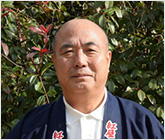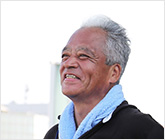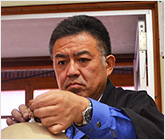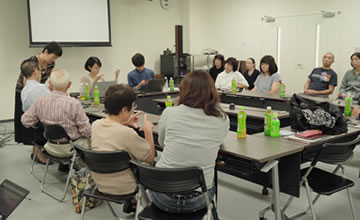The workshop took place at an activity space called Applause Minami-Aoyama, which is operated by the Applause Association as a way to support persons with disabilities in joining the workforce through flower arranging. The space is an official welfare service business for persons with disabilities designated by the Tokyo metropolitan government (Type B Support for Continuous Employment). Persons with disabilities, such as adults with developmental disorders, learn flower arranging techniques in a friendly group setting while also carrying out job tasks. The goal is to create a space that supports people with disabilities and their families in living full lives free from community isolation, working, and making their dreams come true.
Thirteen people working at Applause participated in the recent workshop. It was taught by the members of the Japan HANABI Association, who are some of Japan’s leading pyrotechnic experts.
Meet the instructors
 Akio Aoki,
Akio Aoki,
Beniya Aoki Fireworks Toshikatsu Ogatsu,
Toshikatsu Ogatsu,
Marutamaya Tadanobu Komatsu,
Tadanobu Komatsu,
Komatsu Fireworks
The first session was taught by Akio Aoki, President of Beniya Aoki Fireworks in Nagano. President Aoki is the third-generation head of his company and a regular winner at national fireworks festivals. He is involved in many fireworks events in his native Nagano, including the Suwa Lake Fireworks Festival, as well as many other fireworks festivals. He serves as chairman of the Japan Fireworks Artists Association, another collection of some of the biggest names in Japanese fireworks. The industry’s leading expert, Aoki was even awarded the illustrious Prime Minister’s Prize at the national competitions in both in Omagari and Tsuchiura.
Another participating instructor was Toshikatsu Ogatsu, President of Marutamaya in Tokyo. President Ogatsu has the world’s largest computer infrastructure dedicated to fireworks, and has been involved in directing and producing fireworks events across Japan and around the globe—most notably the Tokyo Bay Grand Fireworks Festival and the Setagaya-Tamagawa Fireworks Festival, as well as the grand finale at the Kanagawa Shimbun Fireworks Festival. Ogatsu is the leading producer in the fireworks industry today.
The instructor for the third workshop session was Tadanobu Komatsu, President of Komatsu Fireworks in Akita. President Komatsu is the fifth-generation head of Komatsu Fireworks. Komatsu is a renowned pyrotechnician in the Tohoku area, playing a key role in the Omagari National Fireworks Competition—one of Japan’s three most important fireworks festivals. Komatsu takes charge of manufacturing and launching fireworks for festivals, events, and competitions nationwide, with a particular focus on the Tohoku area. He was awarded the prestigious Prime Minister’s Prize at the 87th Omagari National Fireworks Competition in 2013.
The instructor for the second and fourth workshop sessions was Sei Iwano, Marketing Director at Marutamaya. Working under President Ogatsu at Marutamaya, Iwano is one of the industries up-and-coming young leaders, involved in the production of numerous fireworks festivals and fireworks attractions throughout Japan.
Workshop report
First SessionJune 2, 2017
Topics
・The history of fireworks
・Fireworks in Japan, manufacturing technologies
・Types of fireworks
・Modern fireworks, entertainment-style fireworks
・Design theme
The first session was taught by President Aoki of Beniya Aoki Fireworks in Nagano and by President Ogatsu of Marutamaya in Tokyo. President Aoki prepared a slideshow for the day’s presentation, which was full of fascinating material. Participants learned about the origin of fireworks as well as the fact that Tokugawa Ieyasu was responsible for launching Japan’s first firework, and that it was brought into the country from England.
President Ogatsu talked about fireworks manufacturing. He used a model of a shell to explain how the inside of the shells are constructed, how the opening of each shell is timed, and more, presenting the technical details in a way that was clear and easy to understand.
Fireworks use many colors—reds, blues, greens, and more—but there is actually no limit to the colors. It’s the pyrotechnician that’s responsible for making subtle changes to the way each color appears, each expert taking on his own characteristic style over time.
The participants asked all kinds of questions during the Q&A period, including how the colors were made, how long fireworks burn, and the difference between fireworks that leave a trail and those that don‘t. Everyone was extremely engaged during this portion of the workshop in an attempt to find out what fireworks were capable of as they considered their personal firework designs.
Despite the limited time, the participants were able to get all of their questions asked before the day’s session was over. They were then asked to start working on their individual designs.
Second SessionJune 9, 2017
Topics
・The Star Mine bouquet launch method
・Q&A session
・Announcement of selected designs
・Advice on selected designs
The second day of the workshop was led by Sei Iwano of Marutamaya. The thirteen participants had submitted eighteen designs following the previous workshop.
The session kicked off with each of the participants presenting their designs. The idea was to have them talk about not only the design, but their reasons behind it, the creative techniques they used, how it might be used as a firework, and so on. It was clear from the presentations that the participants had already learned a great deal in a short amount of time.
After the presentations were finished, the workshop continued with Iwano talking about Marutamaya’s specialty, fireworks set to music, as well as the Star Mine launch method, which sets off multiple small fireworks in rapid succession and is critical to creating musical fireworks displays.
The design theme for the workshop was the Olympic victory bouquet, and the Star Mine method is ideal for displaying that kind of bouquet. The participants listened as Iwano explained about the kinds of fireworks that could be included in a Star Mine presentation and the kinds of visuals it could be used to create. This was followed by a discussion of how each person’s design could be refined for use in a sixty-second fireworks presentation.
Finally, at the end of the session, six designs were chosen based on discussions with the pyrotechnicians who would actually be manufacturing the fireworks. The participants really put a lot of thought into every design, making it incredibly difficult to choose just six of them. The submissions were full of ideas that the fireworks experts had never even considered, and many inspired them to go out and try things that they never had before. Even the pyrotechnicians felt that the designs were fresh and exciting.
The six designers whose work was chosen were asked to come up with ideas for a fireworks program lasting about a minute, which they would present at the next workshop session.
Third SessionJune 13, 2017
Topics
・Types of display methods (programming, sequencing, music, etc.)
・Advice, touching up the designs
Suggestions for the actual fireworks presentation were finally discussed on the third day of the workshop. The instructors for this session were President Komatsu of Komatsu Fireworks in Akita and President Ogatsu of Marutamaya in Tokyo, who was presenting for the second time.
This session kicked off with a discussion of how the programming and sequencing might work for the selected design. The fireworks experts led the discussion based on the programming ideas that the designers had come up with since the last session. The designers talked with the pyrotechnicians about the kind of display they wanted to create, the kind of color palette it might use, and how the fireworks might be combined in order to achieve the design as they imagined it, how the sixty seconds might be utilized, and so on.
Some of the participants had proposed that their designs be set to music from the beginning, and the fireworks experts and designers shared various ideas about how their ideas might be further improved.
The pyrotechnicians brought all their expertise to bear in responding to the participants’ ideas, taking several topics back with them for further consideration. They decided that they would create fireworks that had never been made before, and both instructors and designers alike seemed to greatly enjoy the discussion.
Creating a new firework involves making a test piece and actually setting it off to see how it does. It’s quite a process. Each design piece was thoroughly discussed, which resulted in several more assignments to be completed by the next session. And with that, the third day of the workshop was brought to a close.
Fourth SessionJune 16, 2017
Topics
・Advice, touching up, and finalizing display methods
Finally, it had come down to the last day of the workshop. The instructor for this session was again Sei Iwano of Marutamaya. President Aoki, President, Komatsu, and President Ogatsu each took the ideas that had been brought forward in the last session home with them in order to think about how the designs could be replicated in fireworks. The experts put their heads together and considered the methods that would work.
Iwano went over these discussions and worked on further fine-tuning of the designs. By the time the fourth session was in progress, even the participants were tossing out technical fireworks terms. It seemed they had somehow found a way to have all kinds of discussions about fireworks during their breaks at work and various other opportunities, and had made a serious effort to study on their own. Even those who were hesitant to share their thoughts at first ended up repeatedly speaking up, confidently exchanging technical terms with the experts. Even the staff at Applause were a bit surprised at the changes they saw.
Apparently, the atmosphere at Applause was typically fairly quiet, with everyone quietly and seriously going about their work. But after a few workshops, there were more conversations in the activity space, and it also seemed that a kind of solidarity was developing among the members. It turned out that having them present their own ideas and get feedback on them really did deepen their interactions with one another.
Iwano shared some of his own thoughts at the end of the workshop as well. Even though the pyrotechnicians had done everything they could to hone their skills within their own field of expertise, their interactions with people completely outside the industry had been an incredibly fresh and fascinating experience. They got to experience a world they had never experienced before by creating fireworks based on the participants’ ideas and try out things that they had never done before.
This marked the end of the four-session workshop. What kinds of fireworks will we get to see on August 19? Of course the designers will be there on the day of the festival to see their own creations. Stay tuned, as we’ll post their experiences and impressions at a later date!








